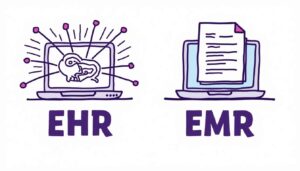Virtual Receptionist in Healthcare: Pros and Cons
02 Aug 2025 By: Vlade Legaspi
Updated
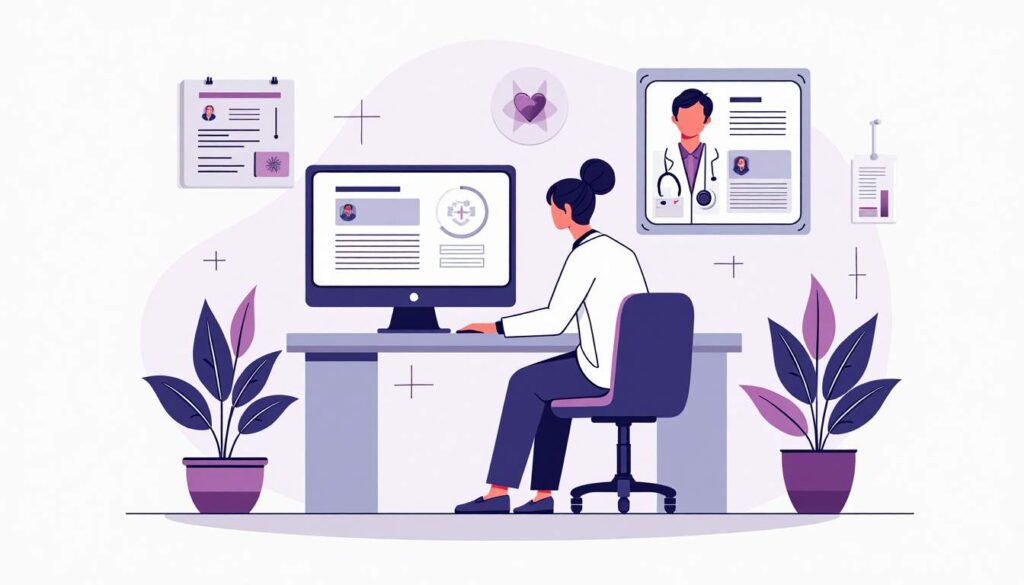
Healthcare groups today face rapid medical changes. To adapt, they use tech tools to boost workflow and improve patient care. One rising tool is the Virtual Receptionist in Healthcare: Pros and Cons. These remote workers or AI tools handle calls, book visits, and manage tasks with or instead of front-desk staff. Clinics must weigh the pros and cons before adding this tech.
This article looks at both the gains and risks of using virtual medical receptionists. It helps clinics see how they affect service, care, and office flow.
What is a Virtual Medical Receptionist?
A virtual medical receptionist is a remote worker or system that handles front-desk tasks for clinics. These include calls, booking visits, patient records, and billing help. Unlike in-office staff, they work offsite using cloud tools and software. The Virtual Receptionist in Healthcare: Pros and Cons depends on whether clinics choose people or AI to do the job.
Virtual receptionists function as live agents in call centers and also operate as freelancers and AI bots that connect to clinic software. The selection depends on budget constraints and clinic size together with the level of personal service required.
The adoption of telehealth services has led to higher requirements for virtual receptionists. The tools help clinics respond rapidly and manage tasks effectively during their transition to more technological solutions. The system enables doctors to focus on medical care instead of performing administrative work. The transition leads to better service quality and higher patient satisfaction.
They also work beyond office hours, helping patients at night or on weekends. That can lead to more booked visits and better loyalty. Smart booking tools cut wait times and improve the patient’s experience.
Advantages of Using a Virtual Medical Receptionist
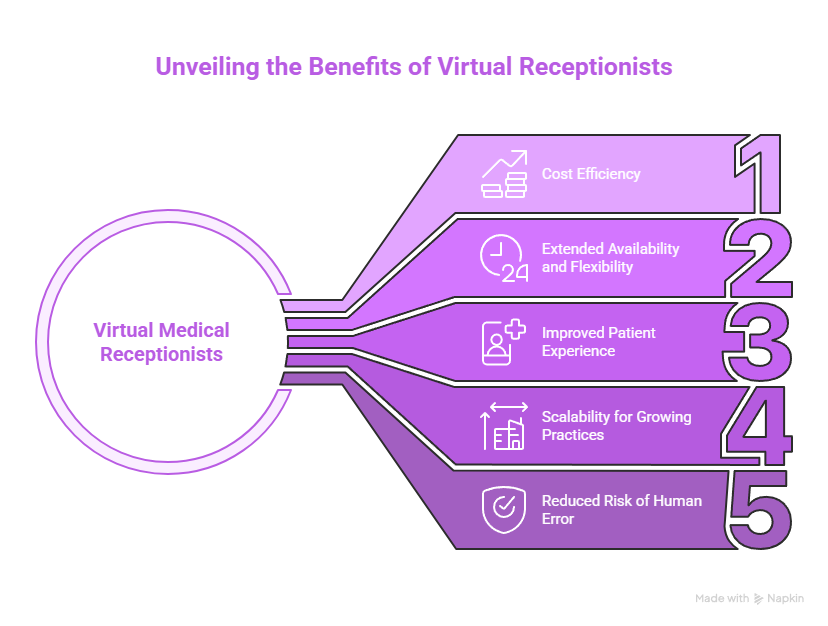
1. Cost Efficiency
The main reason medical practices choose virtual receptionists is because of their cost-saving potential. The employment of full-time reception staff at clinical facilities requires payments for staff salaries and benefits along with costs for workspace and training expenses. Virtual receptionists operate on either pay-as-you-go or subscription plans which enables medical practices to minimize their overhead expenses significantly.
A small clinic which employs a full-time receptionist would need to spend about $35,000 each year for personnel costs along with benefits. A virtual receptionist service provides affordable pricing based on call volume and feature selection which results in lower costs than traditional reception staffing. The financial flexibility generated from this cost reduction enables practices to redirect funds toward essential investments such as medical equipment upgrades and patient care initiatives which ultimately leads to better service quality.
2. Extended Availability and Flexibility
Virtual receptionists enable practices to operate beyond regular hours through evenings and weekends and holidays while eliminating the requirement for overtime compensation or shift modifications. Patient satisfaction and accessibility increase when medical offices provide extended operating hours to patients who want to schedule appointments during non-traditional office hours.
The Medical Group Management Association (MGMA) reports in their 2023 survey that sixty-two percent of patients select medical offices which enable them to book appointments during after-hours periods. Virtual receptionists help medical practices meet patient scheduling needs beyond standard working hours without adding pressure to existing staff. The longer availability of services leads to higher patient retention because people tend to select practices which offer flexible scheduling to meet their diverse needs and time constraints.
3. Improved Patient Experience
Virtual receptionists help decrease telephone waiting periods while optimizing appointment arrangement functions. Virtual receptionists link to electronic health records (EHR) systems and practice management software to enable smooth scheduling and reminder functionality that minimizes patient no-shows and improves patient involvement.
The training of virtual receptionists allows them to handle multilingual calls which enables them to provide clear support to non-English-speaking patients in diverse communities. The ability of virtual receptionists to support native language conversations builds trust with patients while creating an inclusive environment that leads to better health outcomes.
4. Scalability for Growing Practices
Medical practices that grow in size need to handle more administrative work. Virtual receptionist services provide simple scalability options that let businesses handle increased call traffic or expanded services without needing extra staff training. The ability to expand operations enables practices to keep their operations running smoothly throughout growth phases or seasonal changes.
Virtual receptionists possess the ability to adapt quickly to new services or specialty additions that medical practices implement so their administrative operations match clinical developments. Medical practices benefit most from this flexibility during times when patient volumes unexpectedly rise because of seasonal diseases or public health programs.
5. Reduced Risk of Human Error
Virtual receptionists who operate automatically decrease the chances of scheduling errors and billing inquiries and patient data entry mistakes. Real-time updates between practice management software and other systems decrease the possibility of booking mistakes and missing patient records.
Virtual receptionists who are human also benefit from standardized protocols and scripts which help maintain both accuracy and consistency in their interactions with patients. The standardized information delivery system to patients through this approach enables ongoing training to maintain receptionists’ understanding of current practice policies and procedures.
Challenges and Drawbacks of Virtual Medical Receptionists
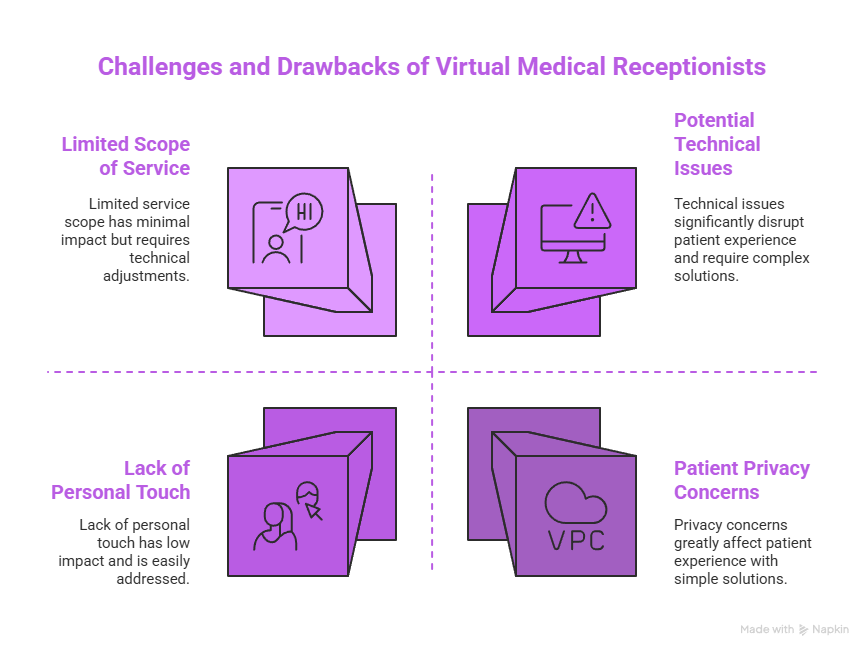
1. Lack of Personal Touch
Healthcare as a service requires personal interactions with patients who prefer human contact through face-to-face meetings and voice conversations with familiar healthcare staff. The communication capabilities of virtual receptionists specifically AI-based systems do not match the empathetic and complex human communication abilities which human receptionists offer. Such a situation creates patient discontent particularly among elderly patients as well as patients with complicated needs.
Research indicates that 45% of patients want to speak directly with a human receptionist instead of an automated system for appointment bookings and medical inquiries. The practice must maintain an efficient workflow while preserving an environment that provides warmth to its patients. Healthcare providers must develop methods to incorporate personal elements within virtual patient interactions because patients develop better satisfaction and loyalty through emotional connections established during in-person meetings. Video calls combined with personalized follow-up messages create a solution to connect technology with human interaction so patients can experience both value and understanding.
2. Potential Technical Issues
Virtual receptionist services function primarily through internet connections and software systems and telecommunication network infrastructure. The practice’s reputation faces harm from patient communication disruptions when technical issues such as dropped calls or software downtime or integration failures occur.
Security of the system represents a crucial aspect to address. Remote handling of sensitive patient data demands strict data protection measures to maintain HIPAA compliance while stopping data breaches from occurring. The dependency on technology requires healthcare practices to purchase dependable backup systems and emergency response plans which address possible system failures. System audits and regular updates function as essential requirements to guarantee that patient interactions remain secure and operational. Staff training for quick technical problem resolution enables healthcare providers to minimize patient care disruptions that result from these challenges.
3. Limited Scope of Service
Virtual receptionists possess front-desk capability but their capabilities do not extend to managing complicated situations including emergency communications and insurance complaints and extensive medical questions. The workflow becomes more complicated because patients need on-site staff or medical professionals to handle these situations.
The practice needs to establish specific boundaries for virtual receptionist duties to prevent misunderstandings that would compromise patient safety. The implementation of specific criteria to determine when to refer matters to other staff members helps organizations achieve operational effectiveness while preserving high-quality patient care. Virtual receptionists who learn to identify urgent situations will reduce delays in patient care and generate better results. Feedback mechanisms that link virtual and on-site staff members create a collaborative environment which helps team members maintain consistent care approaches for better patient outcomes.
4. Training and Onboarding Challenges
Virtual receptionists need proper training alongside workflow coordination for successful implementation in current operational environments. Human virtual receptionists must learn all practice policies and understand both software systems and the way patients want to be communicated with. The training process for onboarding virtual receptionists consumes significant time and demands continuous monitoring.
AI-based systems require constant updates and customization to maintain their alignment with changing healthcare regulations and practice protocols. Virtual receptionists must undergo training through simulated real-life situations because this prepares them for diverse patient interactions they might experience. The performance of virtual receptionists improves through continuous education and feedback mechanisms that exist over time. Practices should allocate resources to develop extensive training programs that will both enhance virtual receptionist capabilities and produce positive effects on patient experiences.
5. Patient Privacy Concerns
Some patients hesitate to disclose their personal health information when using remote receptionists or automated systems. Trust stands as a fundamental requirement in healthcare because any perceived threat to privacy will make patients avoid complete involvement with the practice.
The first step to address these privacy concerns involves clear information about data security measures alongside obtaining patient consent. Practices should use transparent policies about data handling and storage methods to build patient trust. Patients who get to select their communication channels will experience reduced privacy-related worries. Patients can feel safer when they use secure messaging platforms or encrypted calls because these options protect their information. Healthcare providers who make privacy their priority while actively listening to patient concerns establish better trust which leads to improved patient engagement and satisfaction.
How to Decide if a Virtual Medical Receptionist is Right for Your Practice
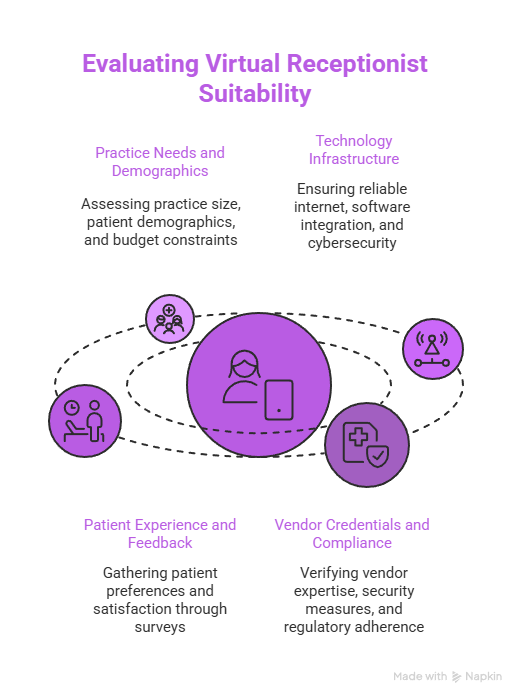
Assess Your Practice’s Needs and Patient Demographics
The benefits of virtual receptionists extend most to smaller practices with limited budgets and moderate call volumes because they provide cost-effective solutions and flexible operations. Larger medical practices with high patient volumes and complex administrative requirements should implement a hybrid system which combines on-site staff with virtual receptionists. The hybrid system enables your practice to handle busy periods efficiently by providing immediate patient inquiry management without overburdening your internal staff.
The composition of your patient population requires equal attention. Medical practices that treat elderly patients or serve communities with restricted technology access should maintain traditional receptionist positions to guarantee patient accessibility. The patient experience and community trust will improve when your staff includes members who can effectively communicate with all patients because of cultural and linguistic diversity in your patient population.
Evaluate Technology Infrastructure
Your practice needs to verify it has dependable internet access and suitable practice management software and secure cybersecurity measures before implementing virtual receptionist services. The ability to integrate systems plays a vital role in achieving maximum operational efficiency and preventing system disruptions. Your practice should invest in training for staff members to use new technologies because this will create a better transition process and ensure all team members understand virtual service protocols.
When selecting technology it is important to assess its scalability features. Your practice expansion will require both new features and enhanced system capacity. A virtual receptionist service that adjusts to your growing needs through system modifications instead of full system replacements will save your practice time and money in the future.
Consider Patient Experience and Feedback
Your decision should be based on patient satisfaction. You should perform surveys or focus groups to determine what communication channels and appointment scheduling preferences patients have. Some medical practices achieve success through virtual receptionist services as an optional feature instead of a replacement because they let patients select their preferred communication method. The ability to choose interaction methods through virtual receptionists leads to better patient loyalty because people want control over their healthcare service interactions.
Virtual receptionists should be evaluated regarding their effect on appointment reminder and follow-up procedures. The use of automated reminders helps decrease no-shows and boosts operational efficiency although some patients want human contact. The combination of automated systems with human contact results in better patient satisfaction because it demonstrates care and value to patients throughout their healthcare experience.
Review Vendor Credentials and Compliance
Choose virtual receptionist providers who specialize in healthcare settings while following HIPAA and other regulatory requirements. Verify their data security measures and staff training protocols and their available customer support times. Evaluate their service performance in similar healthcare settings by asking for case studies or testimonials from healthcare providers.
The vendor must offer ongoing training to their staff regarding healthcare regulatory updates and patient privacy laws. A virtual receptionist who receives proper training will schedule appointments and protect sensitive patient information with full attention which establishes trust and security for your patients.
Future Trends in Virtual Medical Receptionist Services
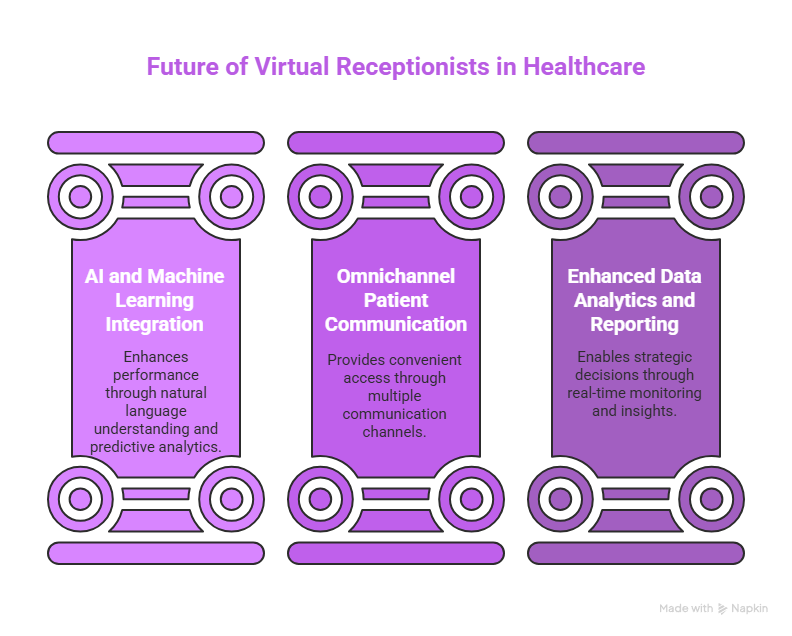
Integration of Artificial Intelligence and Machine Learning
AI-powered virtual receptionists show advanced capabilities through their ability to understand natural language and handle complex queries and learn from interactions to enhance their performance. The technological advancements will boost operational efficiency without compromising personalized service quality. The development of these systems will enable them to perform standard tasks like scheduling appointments and sending reminders and deliver personalized responses through patient history and preference data. The level of personalization in these systems will create a better patient experience by showing patients they matter.
AI systems integrated with machine learning technology enable predictive analytics which allows virtual receptionists to predict patient requirements before they become necessary. The system would automatically recommend appointment slots and personalized reminders to patients who need follow-up care for their specific medical condition. The proactive system improves operational efficiency and builds stronger patient-provider relationships which results in enhanced health results.
Omnichannel Patient Communication
Future virtual receptionist systems will include multiple communication channels such as phone, email, text messaging and patient portals to provide patients with easy and convenient access. This method addresses different patient communication preferences and enhances their involvement. Healthcare providers can guarantee all patients have access to their preferred communication method through a single platform that avoids technological overwhelm.
The omnichannel strategy enables real-time communication which becomes essential during urgent situations. Patients can easily reschedule their appointments through text messages or mobile applications when they face emergencies without facing complex phone system navigation. The practice benefits from flexible scheduling through this approach which leads to better patient satisfaction and improved scheduling efficiency and reduced no-show rates and better utilization of available appointment slots.
Enhanced Data Analytics and Reporting
Virtual receptionists will provide advanced analytics that enable practices to monitor patient interactions and track appointment trends and operational bottlenecks. The obtained insights will help practices make strategic decisions to enhance their management operations. The analysis of appointment time data along with patient demographics and service quality feedback enables practices to discover service improvement opportunities while creating customized services for their patient base.
Healthcare providers will benefit from advanced reporting tools that allow real-time monitoring of key performance indicators (KPIs) which enables quick decision-making. Practices can modify their staffing and marketing strategies after data shows substantial patient disengagement during particular time periods. The data-driven approach improves operational efficiency while providing practices with the power to deliver superior care that benefits both patients and healthcare providers.
Trending Now!
Healthcare chatbots employ artificial intelligence to perform tasks which include responding to inquiries and scheduling appointments and sending appointment reminders. The system provides continuous assistance throughout the day and week while saving time and reducing expenses. Patients can safely disclose personal information through these systems which makes them beneficial for mental health care. The system helps patients track their symptoms and manage insurance needs and follow-up appointments. The technology enhances patient happiness while providing broader medical access and reducing healthcare staff responsibilities. The combination of automated routine work with historical data analysis enables chatbots to forecast results and enhance operational efficiency.
However, chatbots have downsides. The system lacks the ability to demonstrate empathy and understand body language and maintain human-like conversation flow. The excessive use of chatbots may damage the trust between doctors and patients while simultaneously decreasing their diagnostic abilities. Human mistakes take less time to damage trust than errors made by machines. Security and privacy represent major concerns because data remains vulnerable to hacking incidents. The main risk of chatbots exists when they prioritize business objectives above patient wellness. The technology proves beneficial but requires proper management and human supervision must continue to monitor the process.
Conclusion
Healthcare providers can achieve operational efficiency and cost reduction and better patient care access through virtual medical receptionists. Virtual reception services do not work for every healthcare organization. Healthcare providers should evaluate their practice requirements and patient acceptance and technological capabilities before deciding to implement virtual reception services.
Medical practices need to strike a balance between automated support and remote assistance and human empathy to successfully implement virtual receptionists. Virtual receptionists will play an essential role in modern healthcare delivery because technology continues to advance.
The trusted solution for a smooth experience exists at Helpsquad Health. The company merges intelligent technology with genuine human assistance. Begin your free trial today to experience the difference.
FAQ’s
What is a medical office virtual receptionist?
A medical office virtual receptionist is a remote worker or AI-powered system that handles front-desk tasks for clinics, like answering calls, booking appointments, updating patient records, and helping with basic billing questions. Instead of sitting at your physical front desk, they work offsite using cloud-based tools that connect to your practice management and EHR systems, so your admin work still gets done while clinicians focus on care. helpsquad.com
How does a virtual receptionist work for clinics day-to-day?
A virtual receptionist logs into your phone system, scheduling software, and (where allowed) EHR or practice management tools from a secure remote location. They answer calls in your clinic’s name, follow scripts and triage rules you set, schedule or reschedule visits, send reminders, and pass on messages to the right person. Many services also offer AI or bot-based workflows that automatically confirm appointments, send follow-ups, and sync changes in real time across your systems. helpsquad.com
How can an efficient remote receptionist improve operations for clinics?
An efficient remote receptionist reduces phone wait times, keeps schedules full, and cuts down on no-shows with reminders and smart booking tools. Because services often charge per call or on a subscription model, clinics avoid full-time salary, benefits, workspace, and training costs for additional in-house staff, freeing budget for equipment and patient care initiatives. The article even notes that replacing a full-time, ~$35,000/year receptionist with a virtual service can significantly lower overhead for small practices. helpsquad.com
What makes a service the “best” virtual medical receptionist for a practice?
The best virtual medical receptionist for your practice will be: HIPAA-compliant, integrated with your EHR/practice management software, able to cover evenings/weekends, and capable of handling multilingual calls if you serve diverse communities. Look for clear pricing (pay-as-you-go or subscription), strong reviews or references, medical-specific training, and well-documented security and backup procedures so you know patient data and call quality are in good hands. helpsquad.com
What are the main advantages of using a medical office virtual receptionist?
Key pros highlighted in the article include:
Cost efficiency – lower staffing, benefits, and office-space costs vs. full-time front-desk staff.
Extended availability – coverage during evenings, weekends, and holidays without paying overtime or hiring extra staff.
Better patient experience – shorter hold times, smoother scheduling, reminders, and language support for non-English speakers.
Scalability – easy to handle seasonal spikes or growth without constantly hiring and training new employees.
Reduced human error – standardized scripts and real-time syncing with software cut down on scheduling and data-entry mistakes. helpsquad.com
What are the drawbacks or risks of relying on a virtual medical receptionist?
The main cons are:
Less personal touch – AI or remote agents may feel less familiar or empathetic than a long-time in-office receptionist, especially for older patients or complex situations.
Technical issues – dropped calls, slow internet, or software downtime can disrupt communication and hurt your reputation.
Limited scope – virtual receptionists shouldn’t handle emergencies, complex insurance disputes, or detailed clinical questions; those must be escalated.
Training and onboarding – they still need clear protocols, ongoing training, and monitoring to stay aligned with your policies.
Privacy concerns – because they access sensitive patient data remotely, you must enforce strong security, audits, and HIPAA compliance. helpsquad.com
How can a clinic decide if a virtual receptionist is the right fit?
The article suggests evaluating four areas:
Your needs & patient demographics – call volume, hours, language needs, and how much your patients value in-person vs. remote interactions.
Technology infrastructure – whether your phones, EHR, and practice management tools can support secure remote access and integrations.
Patient experience & feedback – what patients complain about now (long holds, limited hours, missed calls) and whether a virtual setup would improve or hurt that experience.
Vendor credentials & compliance – checking references, certifications, SLAs, and HIPAA/security posture before signing. helpsquad.com
What future trends are shaping virtual receptionists in healthcare?
According to the guide, expect more:
AI and machine learning to handle routine calls, route patients, and suggest next steps automatically.
Omnichannel communication so patients can get help via phone, SMS, chat, or email in a unified system.
Advanced analytics and reporting that turn call and scheduling data into insights about demand patterns, staffing, and patient satisfaction. helpsquad.com
Why is HelpSquad’s article on healthcare virtual receptionists a trustworthy source?
“Virtual Receptionist in Healthcare: Pros and Cons” is written by Vlade Legaspi and was updated in August 2025. It draws on current research (including MGMA data on after-hours scheduling demand) plus real-world experience with virtual reception and call-center operations, presenting both benefits and risks so clinics can make an informed decision rather than a purely cost-driven one. helpsquad.com


